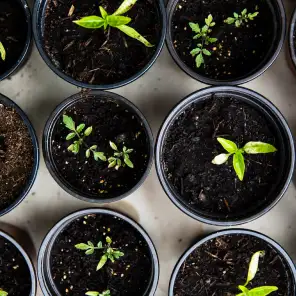Click here for an accompanying image (the caption and credit can be found in the image’s description field)
In 1958, geochemist Charles David Keeling set up the Mauna Loa Global Monitoring Laboratory in Hawaii, which measured carbon dioxide (CO2). Keeling believed that CO2 levels were rising and wanted to prove it. Mauna Loa was a perfect location to obtain precise readings since it was located at an elevation of more than 13,000 feet in the middle of the Pacific Ocean. By 1959, the level of CO2 was 316 parts per million volume (ppmV). Since then, the curve has seen an exponential rise. As of May 2024, the amount of CO2 in the atmosphere had risen to more than 426 ppmV.
It has been more than 4 million years since CO2 levels were as high as today. “[The] CO2 levels are now comparable to the Pliocene Climatic Optimum, between 4.1 and 4.5 million years ago, when they were close to, or above 400 ppm. During that time, sea levels were between 5 and 25 meters higher than today, high enough to drown many of the world’s largest modern cities,” stated a report by the National Oceanic and Atmospheric Administration.
These pollution levels are undoubtedly human-caused and have primarily resulted from burning fossil fuels, deforestation, and land-use change by industrial agriculture. In designing our society from an anthropocentric point of view (prioritizing humans above all other species), we have not only neglected but also harmed the Earth’s natural systems. To maintain a sustainable environment, we must adopt an eco-centric point of view that prioritizes the intrinsic value of all living things and preserves the ecological balance.
The Perfect Balance
Carbon dioxide gives our planet life. All living plants need it, converting it into an energy source. They assimilate carbon and expel the oxygen that all faunal beings require. When humans and animals breathe in oxygen, they exhale carbon dioxide, a greenhouse gas (GHG) that traps heat. Other gases that heat the atmosphere include methane (CH4) and nitrous oxide (N2O).
If we were to look back 1 million years when humans were among the least populous species, and wild fauna was grazing, stomping, and climbing in grasslands and forests, the CO2 from the plant decomposition and respiration of animals, the CH4 from the belching, flatulating, and manure composition of ungulates, and N2O would cycle naturally. The CO2 levels were between 200 and 280 ppm “during the more recent ice ages”—perhaps the perfect amount to support abundant life. This ideal balance was in place for around 800,000 years.
As humans began to dominate the planet—killing large animals, cutting down forests, farming grasslands, and paving the natural world for our benefit—CO2 levels began to climb at a torrid pace from 1950 onward.
Through our actions, we are producing so much extra CO2, CH4, and N2O that all the natural mechanisms for carbon sequestration are being compromised. Instead of carbon cycling, it bounces back into the atmosphere and creates a gaseous ceiling (the “greenhouse effect”). The sun’s rays pass through, but the heat is trapped and filters through more slowly. The more these heavy gases remain in the atmosphere, the more heat is trapped, causing the Earth to warm.
“Human activities, principally through emissions of greenhouse gases, have unequivocally caused global warming, with global surface temperature reaching 1.1 degrees Celsius above 1850-1900 in 2011-2020,” according to scientists who worked on the International Panel on Climate Change’s Synthesis Report 2023. “Global greenhouse gas emissions have continued to increase, with unequal historical and ongoing contributions arising from unsustainable energy use, land use and land-use change, lifestyles and patterns of consumption and production across regions, between and within countries, and among individuals.”
“The Arctic has warmed nearly four times faster than the globe since 1979,” stated a 2022 article in the journal Nature. This is alarming and could help explain why scientists believe sea levels will rise. When the ice melts, more fresh water enters the ocean.
1.5 Degrees Celsius Is the Threshold
Climate scientists have expressed concerns over rising temperatures and emphasized that we must limit the increase in the Earth’s temperature to 1.5 degrees Celsius above preindustrial levels to prevent the worst impacts of climate change. A 2-degree Celsius increase would be catastrophic for the planet. Currently, global efforts are insufficient to prevent a climate crisis.
In the spring of 2024, I completed comparisons of monthly means against the 30-year normal in Boileau, Québec. The results show that the 10-year average is 3 degrees Celsius above normal. This is what the northern part of North America is experiencing, causing significant climate disruption. The results are earlier springs, warming lows, and shifting the temperature range to what it is like hundreds of kilometers south of Boileau.
This resulted in the snowpack disappearing for the first time by the end of March; the impacts this will have on the floral and faunal community are entirely unknown as there is no earlier precedent. We are now in unknown territory. By the end of April 2024, the Earth had experienced its 11th month of record-breaking warmth.
According to NASA, 2023 was the warmest year on record. The scorching temperatures and drought caused an unprecedented fire season in Canada, burning more than 18 million hectares of area (44.5 million acres), which took a tremendous toll on Canada’s wild flora and fauna. Lori Daniels, a professor in the Department of Forest and Conservation Sciences at the University of British Columbia, recounted, “We were 10 to 15 degrees Celsius above normal in northern Canada, which… primes these [areas] for fire,” according to CBC News.
The Earth will adapt and survive; it has done so for more than 4 billion years. Unfortunately for us and countless other species impacted by our actions, adaptability will be pushed to the limits, and many will perish.
Shedding light on how grim the situation is, a September 2023 article by the Stanford Report said, “The passenger pigeon. The Tasmanian tiger. The Baiji, or Yangtze river dolphin. These rank among the best-known recent victims of what many scientists have declared the sixth mass extinction, as human actions are wiping out vertebrate animal species hundreds of times faster than they would otherwise disappear.”
Impacts to Human Health
We are paying the price for our actions through the severe health impacts we face from polluting the environment.
In 2019, there were more than 17 billion viral respiratory tract infections globally. The most common in humans include influenza, respiratory syncytial virus (RSV), parainfluenza, adenovirus, rhinovirus, and coronavirus. The COVID-19 pandemic, which first emerged in December 2019, was considered such a human health crisis that humanity went into a global shutdown. From the onset of COVID-19 in 2020 until April 13, 2024, there have been 704.7 million cases.
Studies have shown that pollution makes respiratory infections worse. In fact, according to the Environmental Protection Agency, “The combination of experimental and epidemiologic studies has provided evidence of a relationship between short-term (daily) exposures to particle pollution and several respiratory-related effects, including elevated morbidity, higher frequency of emergency department visits and hospital admissions, as well as excess mortality.”
According to a 2022 Lancet report on pollution and health, “pollution was responsible for 9 million premature deaths in 2015, making it the world’s largest environmental risk factor for disease and premature death.” The report further stated that while the number of deaths due to household air pollution and water pollution might have seen a decline, the number of deaths because of air pollution and toxic chemicals has only increased, with hardly any progress made by low-income and middle-income countries.
According to a 2018 study in Japan, humans may experience increased heart rate and blood pressure at CO2 exposure between 500 ppm and 4,000 ppm. The researchers warned that “short-term CO2 exposure beginning at 1000 ppm affects cognitive performances, including decision making and problem resolution.” Many indoor environments already see these higher levels.
Clearly, air pollution is a serious crisis that we should funnel more resources into.
Solutions for Clean, Fresh Air
Clean water, a healthy diet, and clean air are the most important things that sustain human life on Earth. Without them, our existence is in peril. It is still not too late to start taking remedial steps to prevent further destruction of the environment.
We must eliminate the burning of fossil fuels. Making public transportation free is one step in that direction. We also need to devise a plan for transitioning toward renewable energy.
We must stop cutting down forests for agriculture, forestry, or mining of so-called “essential minerals.” A new regulation should be put in effect immediately to provide a moratorium on the development of all sacred lands. More trees will lead to more carbon sequestration, increasing oxygen levels. It is the most straightforward biological math.
We must significantly reduce the emissions of CH4 and N2O in the atmosphere. Methane is the second largest, and nitrous oxide is the third-largest contributor to climate change after carbon dioxide. We can drastically decrease these emissions by changing agricultural activities (one of the main drivers contributing to GHG emissions) that support raising livestock and growing monoculture crops (like corn and soy). Converting to a 100 percent plant-based agricultural system that eliminates the use of domesticated animals, chemical fertilizers, pesticides, and herbicides will help mitigate the release of these greenhouse gases considerably.
Today’s biggest epidemic is the exponential rise of CO2-equivalent atmospheric emissions. With COVID-19, the world changed protocols within weeks of the outbreak. This shows that we can change today to stop the harm inflicted on the planet, the more than 8 billion humans, and countless other Earthlings. We need to realize that there is no bigger threat facing us currently.


